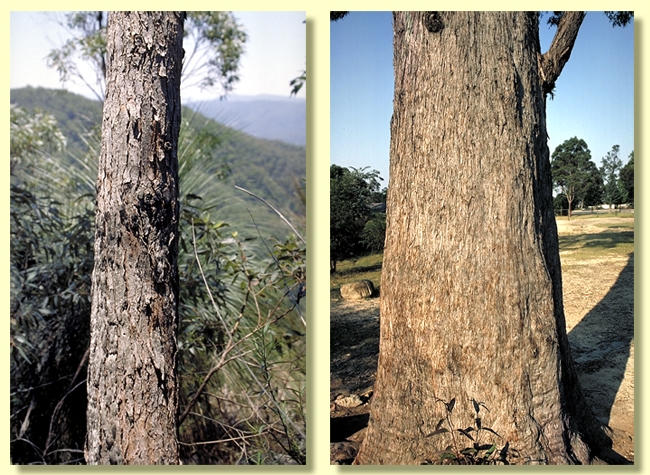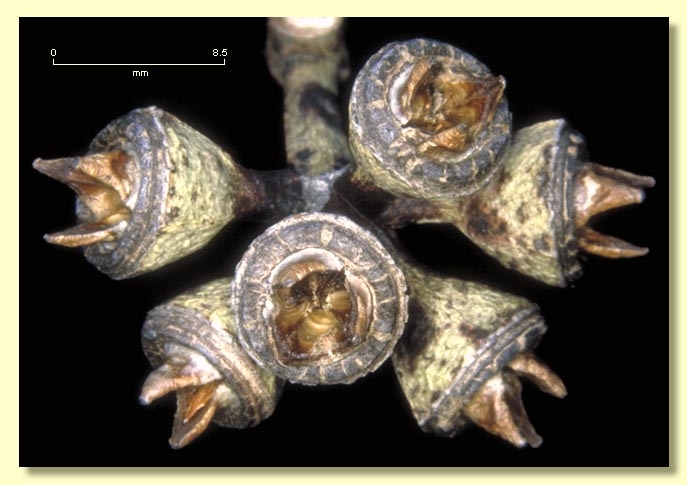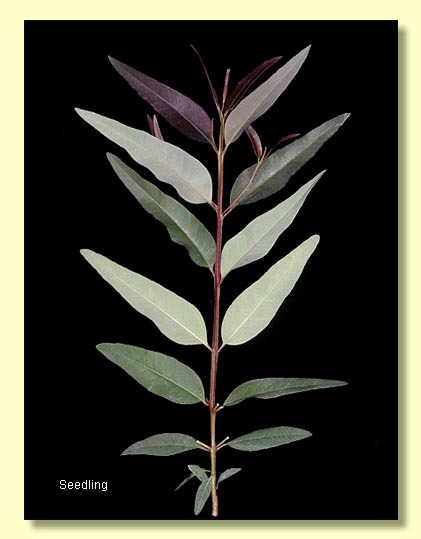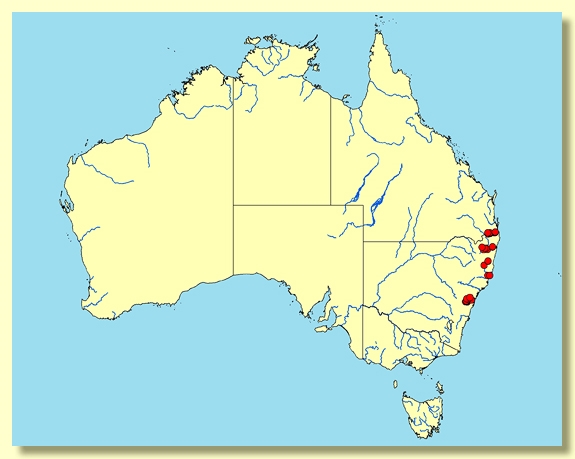Euclid - Online edition
Eucalyptus notabilis
Eucalyptus | Symphyomyrtus | Latoangulatae | Annulares
T: Glenbrook, (Lapstone Hill to Springwood), NSW, Nov. 1904, J.H.Maiden & R.H.Cambage s.n.; holo: NSW.
Bark rough to small branches, fibrous, brown-grey, fissured longitudinally forming broad flat strips.
Juvenile growth (coppice or field seedlings to 50 cm): stems square in cross-section; juvenile leaves always petiolate, opposite for about 4–7 pairs then alternate, lanceolate, 7–13 cm long, 1.8–4.5 cm wide, base rounded to tapering, discolorous, dull, green.
Adult leaves alternate, petiole 1–3.5 cm long, lanceolate to falcate, 7–19 cm long, 1.5–3.3 cm wide, base tapering to petiole, discolorous, glossy, green, strongly penniveined, densely to very densely reticulate, intramarginal vein parallel to and remote from margin, oil glands mostly island.
Inflorescence axillary unbranched, peduncles 0.5–1.5 cm long, 7 to ?11-flowered; buds sessile or pedicellate (pedicels 0–0.5 cm long). Mature buds ovoid to pyriform (0.8–1.2 cm long, 0.5–0.7 cm wide), sometimes with longitudinal ribs, scar present, operculum conical to rounded to beaked, stamens irregularly flexed, anthers cuboid to oblong, versatile, dorsifixed, dehiscing by longitudinal slits (non-confluent), style long, stigma tapered, locules 3 or 4, the placentae each with 6 vertical rows of ovules. Flowers white.
Fruit sessile or pedicellate (pedicels 0–0.5 cm long), hemispherical or obconical, 0.4–0.9 cm long, 0.6–1 cm wide, sometimes longitudinally ribbed, disc slightly raised, level or slightly descending, valves 3 or 4, strongly exserted.
Seeds brown or yellow, 1–2.2 mm long, bluntly pyramidal or cuboid-ovoid, dorsal surface smooth or pitted, hilum usually terminal.
Cultivated seedlings (measured at ca node 10): cotyledons bilobed; stems square in cross-section; leaves always petiolate, opposite for 4–6 nodes then alternate, ovate-lanceolate, 7–13 cm long, 1.8–4 cm wide, base tapering, margin entire, apex pointed, discolorous, dull, dark green above.
Flowering has been recorded in October.
A small to medium-sized tree or rarely mallee found in Queensland and New South Wales. Eucalyptus notabilis is confined to coastal hills on the western rim of the Camden Haven, Nambucca and Clarence basins, and eastern edge of the Central and Northern Tablelands from Bargo in New South Wales north to the Gibraltar Range and Mt Barney, Mt Maroon and Lamington National Parks in far south-eastern Queensland border regions. It is one of the red mahoganies and therefore characterised by thick, reddish grey fibrous rough bark, adult leaves glossy green on upper surface and much paler beneath, buds clusters on flattened peduncles widening apically, more or less obconical fruit with near vertical disc and stongly exserted valves, and cuboid-ovoid seeds.
Eucalyptus notabilis belongs in Eucalyptus subgenus Symphyomyrtus section Latoangulatae because cotyledons are bilobed, leaves are discolorous and have side-veins at a wide angle to the midrib, buds have two opercula and fruit have exserted valves. Within this section, E. notabilis is one of seven species forming series Annulares (the red mahoganies), as it has ovules in six or eight rows, seeds cuboid to pyramidal and bark rough over the trunk. The other six species are E. pellita from coastal north Queensland and New Guinea; E. urophylla from Timor and other islands to the north-west of Australia; E. scias endemic to New South Wales from the coastal and subcoastal ranges, principally from Batemans Bay north to Cessnock with a disjunct occurence east of Tenterfield (subsp. apoda); E. resinifera (with two subspecies) and E. robusta, both widespread in coastal New South Wales and Queensland; and E. botryoides from coastal eastern Victoria and southern New South Wales. Of these, E. notabilis is very closely related to E. pellita, E. urophylla and E. scias. All four have relatively short, fat buds where the operculum is usually wider at the base than the hypanthium. E. notabilis differs from this group by the stony, infertile habitat, relatively small buds and fruit, and consistently short opercula. E. resinifera differs by having relatively long narrow buds with an acute operculum, where the base is normally not wider than the hypanthium. E. robusta has cylindrical fruit which normally have the tips of the valves still joined across the orifice after seed is shed. (The fruit ofE. notabilis are hemisperical to funnel-shaped.) E. botryoides has sessile to shortly pedicellate oblong buds and cylindrical to barrel-shaped fruit.













